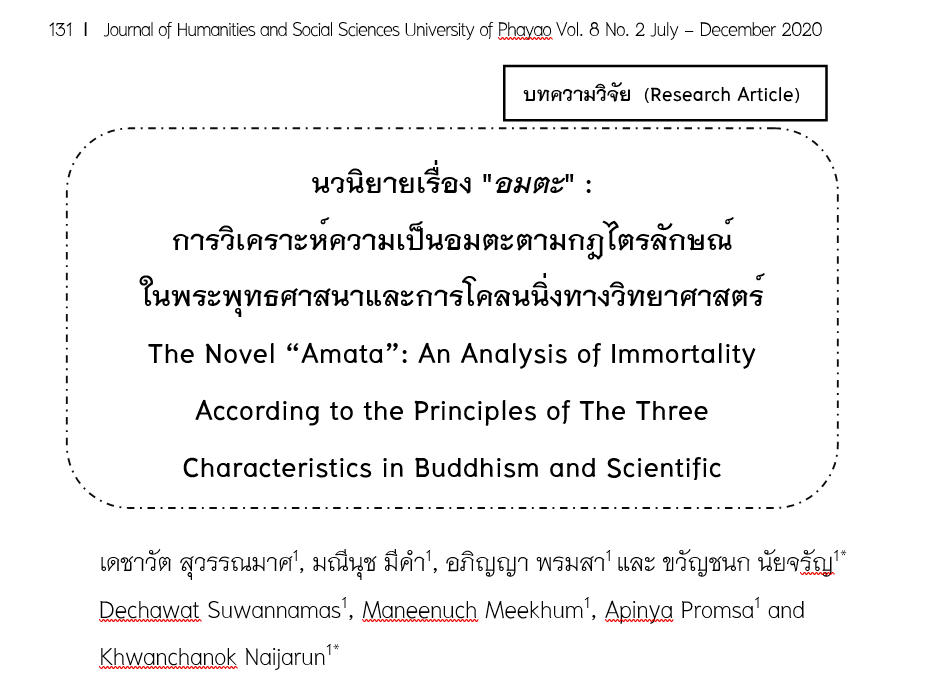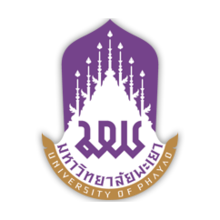The Novel “Amata”: An Analysis of Immortality According to the Principles of The Three Characteristics in Buddhism and Scientific
Keywords:
Immortality, Science, BuddhismAbstract
This research had as objectives to: 1) study the relationship between immortality from the perspective of Buddhism and science, 2) to study the differences between immortality from the perspective of Buddhism and science from the novel about “Amata” of Wimon Saininuan. This study was a qualitative research. Data were analyzed using descriptive analysis. The research results found that immortality from the Buddhism and science perspective has a relationship as follows: Tilakkhana (the three characteristics) from the Aniccata (impermanence) in Buddhism and cloning from the science perspective see physical deterioration in the human body. Dukkhata (state of suffering) in Buddhism and cloning from the science perspective say that the physical deterioration in the human body with time makes humans uncomfortable, Stress and Conflict. Anatta (soullessness) perspective in Buddhism and cloning from the science perspective, tries to search for ways and solutions to create comfort and make the human being not sad and not distressed. The Novel concentrates on the human body. Therefore, Tilakkhana following the Buddhism perspective and Cloning from the science perspective has a relationship as all of them are concern about the existence of the body to make humans immortal, but they differ in their processes and practice. Buddhism teaches humans to accept things the way they happen in order enter nirvana (Niphphan) but the scientist think that humans can overcome the physical deteriorations in the human body. Therefore, they search and invent cloning to meet human needs make humans immortal.
References
ธัญธิติ เฉตวงษ์. (2558). มาตรการทางกฎหมายอาญาในการควบคุมการโคลนนิ่งมนุษย์. [ออนไลน์]. สืบค้นเมื่อ 13 กุมภาพันธ์ 2562, ที่มาจาก: http://ethesisarchive.library.tu.ac.th/thesis/2015/TU_2015_5501033574_4130_3222.pdf
พระพรหมคุณาภรณ์ (ป.อ. ปยุตฺโต). (2544). พุทธธรรม. กรุงเทพฯ: ธรรมสภา, 60.
พระมหาสุนันท์ จนฺทโสภโณ (ดิษฐ์สุนนท์). (2549). การศึกษาคำสอนเรื่องไตรลักษณ์ในพระพุทธศาสนา. วิทยานิพนธ์พุทธศาสตรมหาบัณฑิต (พธ.บ.), มหาวิทยาลัยมหาจุฬาลงกรณราชวิทยาลัย.
ยงยุทธ ยุทธวงศ์. (2544). โคลนนิ่งเทคโนโลยีสะท้านโลก. กรุงเทพฯ: สำนักงานพัฒนาวิทยาศาสตร์และเทคโนโลยีแห่งชาติ, 151.
วิมล ไทรนิ่มนวล. (2543). อมตะ. กรุงเทพฯ: สยามประเทศ.
อุดม เชยกีวงศ์. (2548). พระธรรม. กรุงเทพฯ: แสงดาว, 169.

Downloads
Published
How to Cite
Issue
Section
License
ผู้นิพนธ์ต้องรับผิดชอบข้อความในบทนิพนธ์ของตน มหาวิทยาลัยพะเยาไม่จำเป็นต้องเห็นด้วยกับบทความที่ตีพิมพ์เสมอไป ผู้สนใจสามารถคัดลอก และนำไปใช้ได้ แต่จะต้องขออนุมัติเจ้าของ และได้รับการอนุมัติเป็นลายลักษณ์อักษรก่อน พร้อมกับมีการอ้างอิงและกล่าวคำขอบคุณให้ถูกต้องด้วย
The authors are themselves responsible for their contents. Signed articles may not always reflect the opinion of University of Phayao. The articles can be reproduced and reprinted, provided that permission is given by the authors and acknowledgement must be given.







